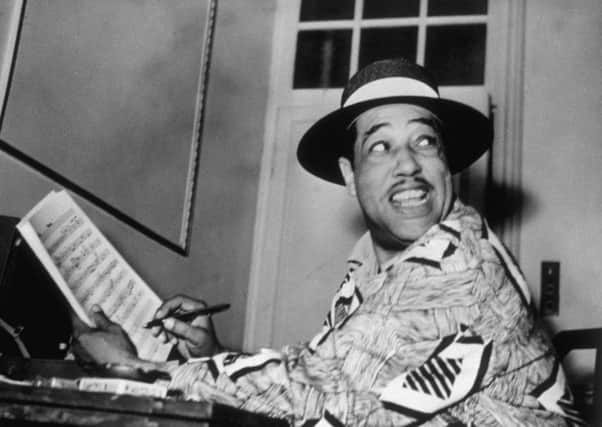Book review: Duke: A Life of Duke Ellington


Duke: A Life of Duke Ellington
TERRY TEACHOUT
The Robson Press, 496pp, £25
He triumphed on both counts. Ellington played piano, but his real instrument was the orchestra. The sound he created was a tapestry of bluesy textures, lowdown swing and solo instrumental voices that growled, cried or wailed. His compositions, from It Don’t Mean a Thing (if It Ain’t Got That Swing) to the Black, Brown and Beige suite, glorified the black experience and earned him comparisons to Prokofiev and Stravinsky. All the while he had one crowning goal: to entertain “without compromising the dignity of the Negro people.”
His was a grand tightrope act. Dressed in tails, grinning broadly from the piano, he was suave and impeccable. Ellington couldn’t let the public see his flaws, and he had many, from his relentless womanizing to his penchant for hogging credit from his collaborators. He knew that a black man in his position had to seem superhuman; anything less might cause a response articulated by Lena Horne: “There go those black people messing up again.”
Advertisement
Hide AdIn his 1973 memoir, Music Is My Mistress, he merely polished the facade. A 1987 biography by James Lincoln Collier focused on the music and sidestepped the personality. Ellington’s newest biographer, Terry Teachout, delves behind “the mask of smiling, noncommittal urbanity that he showed to the world.”As in his biography of Louis Armstrong, he keeps his psychoanalysing within safe limits; he contextualises historically without sounding contrived, and honours his subject’s musical achievements through just the right amount of close analysis.
He traces Ellington’s cultivated veneer to his turn-of-the-century childhood in Washington DC. Middle-class blacks of the time, like his parents, knew that upward mobility depended on adopting the whitest mannerisms possible. Ellington’s father, a butler, dressed and spoke in a high-flown, fussy fashion; he and his wife, Daisy, groomed their son to do the same.
Musically, the young Ellington was largely self-taught, and soon moved away from his first love, ragtime. He unleashed his new sound at the Cotton Club in 1927, and his “jungle music” thrilled white audiences with its raw vivacity. The band’s dark, moaning horns held the essence of the blues; to Ellington, they evoked “the mass singing of slaves.”
He needed a powerful white champion to truly make it big, and he had found one in Irving Mills, a music publisher who managed the band. Mills helped polish its image: he handled the business side and took – up to 50 per cent of the band’s income, doctored many Ellington songs and took co-writer credit. Ellington accepted it all as the necessary trade-off for stardom.
The formula worked. Hits tumbled out of him. He liked to compose piecemeal in rehearsals with the band, assembling songs like jigsaw puzzles. Ellington was no great melodist; his players’ improvised solos were often the source of his tunes. Some later sued him.
One who stayed quiet was Billy Strayhorn, the composer and arranger whom Ellington trombonist Lawrence Brown called “the genius, the power behind the throne.” Meticulously schooled and much more harmonically advanced than his employer, Strayhorn lifted the band to its highest refinement, even though Ellington followed Mills’s example and put himself down as co-author. Professionally, Strayhorn seemed doomed to live in the shadows, in part because he was gay and had opted not to hide it.
Advertisement
Hide AdTeachout relates even the most dramatic episodes in the Ellington story with a poised impartiality. He doesn’t take a novelistic approach, nor does he describe music with the lyrical flights of fancy favoured by such writers as Greil Marcus and Lester Bangs. He particularly shines in his portraits of Ellington’s renowned sidemen, including Jimmie Blanton, Ben Webster, Paul Gonsalves and Juan Tizol. As the largely unsung heroes of the band, they could be angry, sloppy or alcoholic. For all of Ellington’s obsessive drive for control, he hadn’t the nerve to discipline them.
By the late ’40s the swing era had entered a decline, and so did Ellington. His prestige and his record sales sagged; many of his key musicians left. Ellington kept writing ambitious thematic works, but most were panned as pretentious and weak. Rarely had Ellington allowed even a flash of bitterness to peek through, but he couldn’t hide it in 1965, when the Pulitzer Prize board members rejected a proposal to give him a lifetime achievement award. Ellington denounced their snobbery toward nonclassical forms, and hinted at possible racism.
Advertisement
Hide AdIn Teachout’s poignant last pages, the jazz giant is broke and passé, yet still addicted to a lonely life on the road with a band he couldn’t afford to maintain. When he died of pneumonia after a diagnosis of lung cancer, in 1974, he owed the taxman more than half a million dollars.
Yet none of his missteps have dimmed the Ellington legend, and Teachout’s biography ultimately humanises a man whom history has kept on a pedestal.